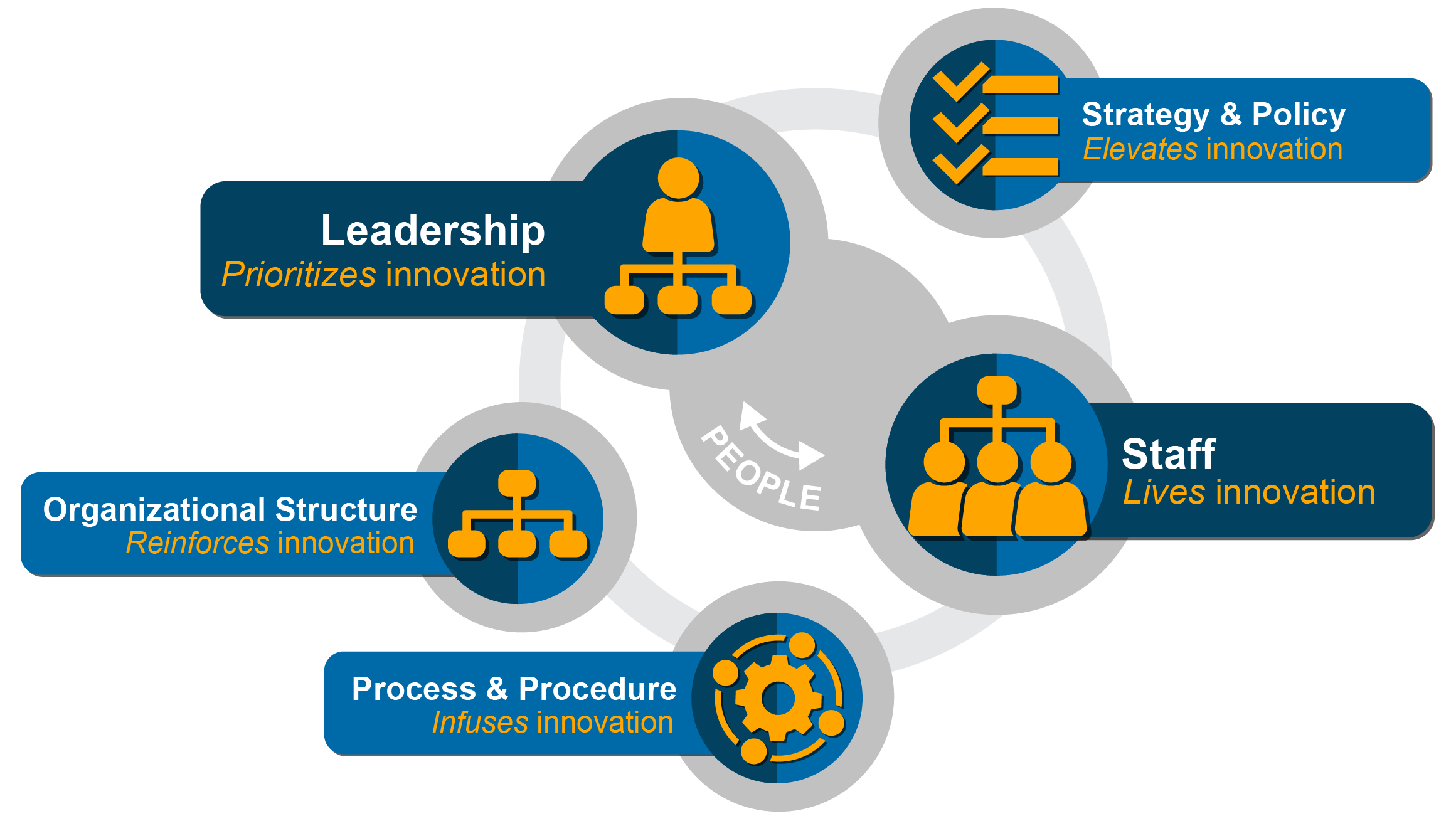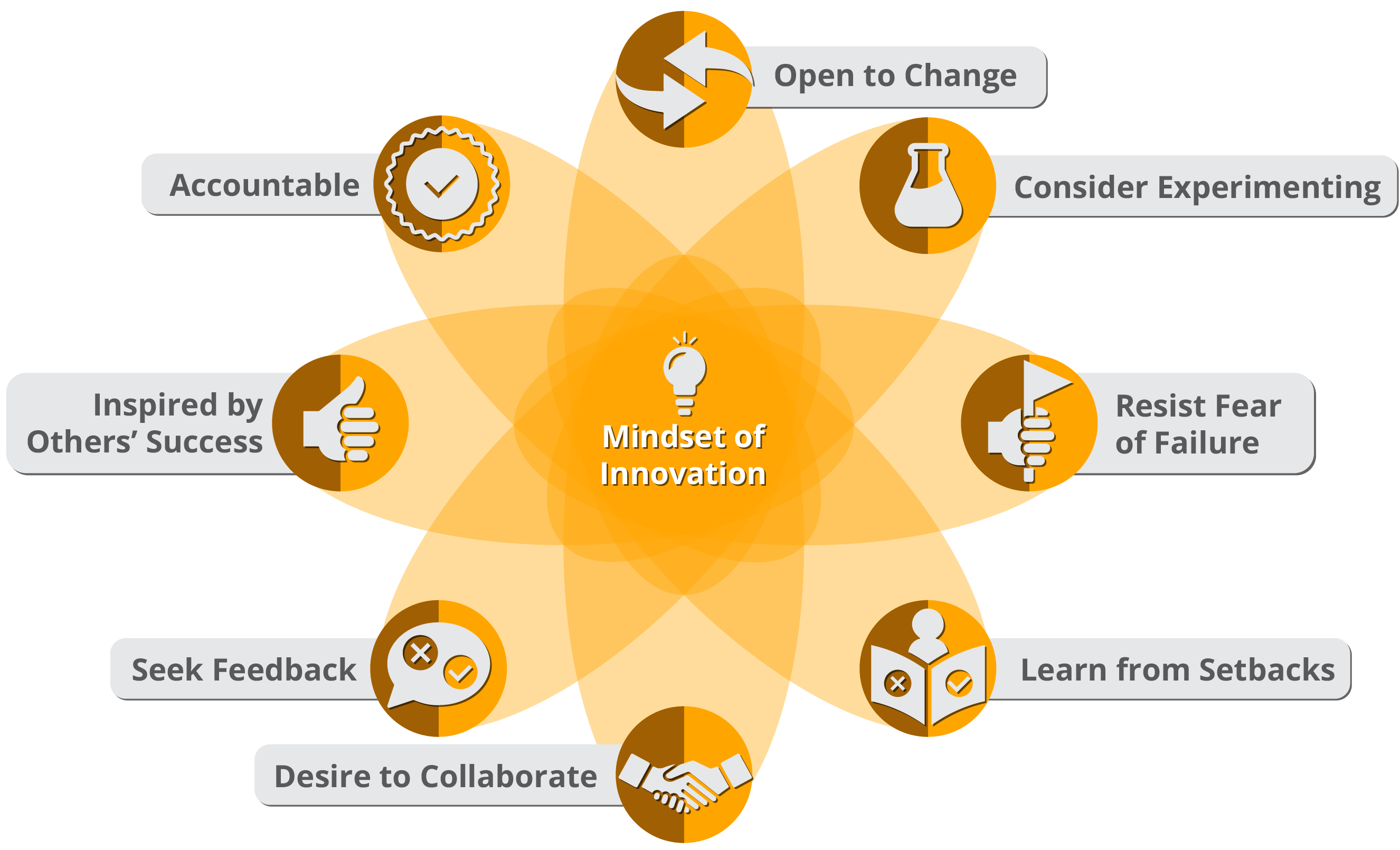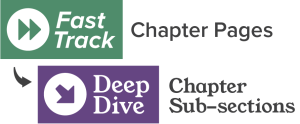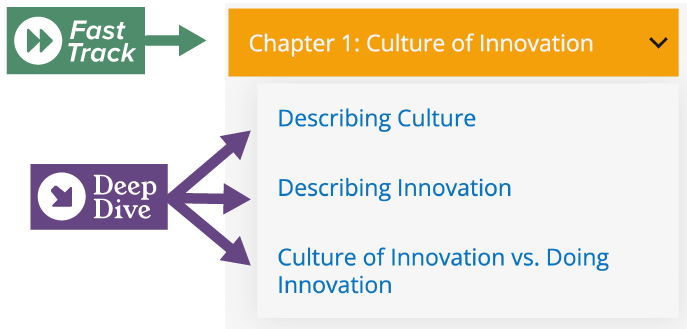
Chapter 2: How to Influence and Develop Culture
Five Organizational Elements That Influence Culture
Culture develops in an airport naturally over time. Research shows that it most often reflects a combination of an airport's leadership style and its overall strategic mission, but culture is also impacted by other organizational elements, such as staff, organizational structure, and process and procedure (as demonstrated in Figure F2.1).

Figure F2.1 Organizational Elements.
Each of these five elements impacts culture in specific ways. For instance,
- Leaders shape an organization (e.g., open/inclusive or siloed/standardized), and their style can influence many other elements in the organization.
- Staff shape an organization by their attitudes and mindset (e.g., open or closed to new ideas).
- Strategy and policy determine what values (e.g., cooperation vs. competition) are prioritized at an airport.
- Organizational structure reinforces the organizational style of the airport structure (e.g., hierarchical vs. flat) that promotes collaborative or individual work, or both.
- Process and procedures demonstrate how to do daily work. These are structured to reward the behaviors leaders want to encourage.
People are critical to the success or failure of a shift in culture; culture is all about people, and only people can make change happen. But this begs a question: Which people-related element is most important? Or, more specifically, which element-leaders or staff-needs to first be on board with the need for a culture shift? The answer: It depends.
Leadership is the clearer answer since leaders have more power in decision-making regarding the other elements, so they can more quickly make changes that can develop an improved culture. But if enough staff members desire a culture change when leaders are not yet on board, they can take action to start making it happen through their behaviors. Good leaders can then be brought on board to support and even drive the change. However, this can be risky for staff members, and it is important to approach this carefully and respectfully.
This page is on the Fast Track. Read this Deep Dive page for more detail on this topic.
Aligning Organizational Elements to Develop a Culture of Innovation
Moving toward a culture that fosters innovation can be done by tapping into the five organizational elements described in the previous section. While it may not be something that happens overnight, Figure F2.2 summarizes how these elements can be aligned to support innovation.

Figure F2.2: Organizational Elements Aligned to Develop a Culture of Innovation.
While Figure F2.2 presents a big-picture view of what the elements can look like, the specifics are up to you. Table F2.1 provides a deeper look, demonstrating how each of the five organizational elements affect cultures of innovation and how they can influence the outcomes and behaviors of organizations.
Table F2.1: Organizational Elements Aligned to Support Innovation.
| Organizational Element | Description & Relevance | Outcomes & Behaviors |
| Leadership drives innovative culture. | In other words, culture is an outcome of leadership established through the development of ideas (processes) not implementation of solutions (inventions). Leaders prioritize innovation, driving change by striving for new thinking instead of old norms. | Staff/teams have a passion for their job, organization, and industry; feel supported and empowered to make decisions; and often inspire others. Staff/teams are encouraged to experiment because they can tie innovation to project budgets and can apply a fail-fast process (see Chapter 5). |
| Staff live innovative culture. | Staff have the freedom and creativity to think independently while maintaining accountability and responsibility for their actions. | Staff/teams embrace a learning and agile mentality and focus on experimenting and exploring. They reach out to others and seek tools and guidance to help them learn. They continually adapt to support ongoing organizational improvement. |
| Strategy & policy elevates innovative culture. | This element sets up the organization's unifying purpose, vision, values and mission. Strategy is customer focused, supports innovation, and is focused on long-term solutions. HR policies enable leaders to hire diverse and innovative staff, as well as reward employees who innovate. | Staff/teams live out the values that are written in the strategic plan, such as agility, diversity, inclusivity, and creativity. They are encouraged to innovate since they have performance reviews, incentives, and recognition programs as motivators. |
| Organizational structure reinforces innovative culture. | The structure embraces a team-based concept (whether within a hierarchical structure or not). Cross-functional collaboration is built in. | Staff/teams like to collaborate and are accountable and responsible to one another. They participate in teams or groups to synergize innovation throughout the organization. |
| Process & procedure infuses innovative culture. | Policies promote embracing new things and focus on continuous improvement. Policies encourage collaboration, innovative training, incentives and rewards programs, allocation of time for deep thinking, and the development of processes for creating a knowledge database and communication. | Staff/teams use shared data to inform decisions; have structured time to innovate collaboratively, both internally and with external stakeholders; and are motivated to learn continually. |
Out of these five organizational elements, two focus on people (leadership and staff). These two areas can make the biggest impact when driving the culture of an organization, but this requires an understanding of people.
Mindset of Innovation
When seeking to nurture the people in your organization toward innovation, the goal is to foster a mindset change. According to Merriam-Webster, mindset can be defined as “a mental attitude or inclination.”1 A mindset affects how a person behaves in an organization (e.g., leader or follower, humble or bold, humorous or serious, outgoing or shy).
People become more innovative once they develop a mindset that encourages it. Changing mindsets will be different for each person. To understand how a mindset relates to innovation, it can be helpful to look at the characteristics that constitute an innovative mindset in Figure F2.3.

Figure F2.3: The Innovative Mindset.
As you uncover the mindset of innovation for yourself, your colleagues, and your airport organization, another aspect that is important to consider is the “personas” of individuals.
This page is on the Fast Track. Read this Deep Dive page for more detail on this topic.
Personas
The research team has summarized the overarching behaviors, values, and norms of individuals in organizations into seven personas you can expect to see as you develop a culture of innovation. Understanding the personas of those around you-as well as yourself-will help you build a team that can effectively and efficiently effect this culture change. Of these seven personas, five are seen as positive personas that support an innovative mindset and that are needed to get innovation going. The remaining two personas are considered negative and can pose challenges or barriers to innovation gaining traction in an organization.
Positive Personas (Things You Want)

Catalyst
Passionate individual always on the lookout for how to engage people, promote new initiatives, and make lasting and sustaining changes in the organization.

Enabler
Supportive of the organization and its people to pursue innovation. Actively promotes transformation initiatives.

Accelerator
Anxious to get initiatives underway and see results. Works to tear down barriers hindering progress.

Sustainer
Carries out necessary roles and responsibilities to sustain innovation initiatives. Does not actively promote initiatives but also does not discourage others. Someone you can count on to get things done in support of innovation.

Challenger
May appear as if they are not on board when they really are; careful and conservative, they want to ensure success.
Negative Personas (Things You Do Not Want)

Inhibitor
Passively refuses to try new ideas and discourages others from participating in organizational initiatives supporting innovation. May lack the ability to empathize with colleagues and see the big picture as it relates to a culture of innovation. Needs coaching and other hands-on training initiatives to improve their perspective.

Destroyer
Actively seeks opportunities to discourage innovation initiatives, and may even consider low levels of sabotage. Lacks emotional maturity and does not work well with others. Unable or unwilling to understand and connect with people around them.
Considerations:
- Think about where people with these types of personas exist in your organization.
- People may fit more than one persona-for example, someone might primarily be a sustainer of innovation, but when they are particularly excited about an idea, they do everything they can to accelerate its traction.
Consider these personas as you develop a team to champion a culture of innovation.


1 Merriam-Webster, Inc., “Mindset,” accessed April 1, 2022, https://www.merriam-webster.com/dictionary/mindset.


